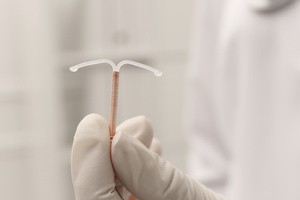 IUDs are T-shaped devices placed in the uterus that can prevent you from getting pregnant for a minimum of three and a maximum of 10 years, depending on the type. With hormonal and non-hormonal options lasting different lengths of time, it’s important to select the IUD that best fits your lifestyle.
IUDs are T-shaped devices placed in the uterus that can prevent you from getting pregnant for a minimum of three and a maximum of 10 years, depending on the type. With hormonal and non-hormonal options lasting different lengths of time, it’s important to select the IUD that best fits your lifestyle.
Read on to explore the key differences between IUD models so you can determine which is right for you based on factors such as hormones, cost, menstrual flow, and length of use. With the aid of your OB/GYN, you can find the perfect IUD match.
Deciding Between Hormonal and Non-Hormonal IUDs
The first decision is whether you want a hormonal or non-hormonal IUD. Hormonal IUDs work by releasing progestin to thicken cervical mucus and thin the uterine lining.
This prevents sperm from reaching an egg and may reduce ovulation. Non-hormonal copper IUDs create a lethal environment for sperm.
Hormonal IUDs offer benefits such as lighter periods and reduced menstrual cramps. They also last 3-8 years on average.
The non-hormonal Paragard IUD contains copper and provides 10 years of pregnancy prevention, but it may worsen bleeding and cramps for some women.
Those wanting to avoid artificial hormones may prefer Paragard, while people with heavy or painful periods often opt for a hormonal IUD to lighten their flow.
Your OB/GYN can help determine if either type is a good fit for you.
Key Aspects to Consider When Selecting an IUD
When narrowing down your IUD options, keep the following in mind:
Desired Length of Use
If you want an IUD that lasts up to 10 years, Paragard is your only option. For 3-8 years of use, a hormonal IUD such as Mirena, Kyleena, or Skyla may be preferable.
Consider how long you wish to prevent pregnancy before replacing your IUD.
Comfort with Hormones
As mentioned, those wanting to avoid artificial hormones may want Paragard, while people with menstrual issues often benefit from hormones in Mirena, Skyla, Kyleena, or Liletta.
Having said that, hormonal IUDs are associated with very low levels of hormone exposure and the rate of systemic side effects are very rare compared with other hormone based birth controls.
Think about your comfort with hormones before deciding.
Menstrual Flow Preferences
 Hormonal IUDs often lighten periods or eliminate them completely. Paragard can increase bleeding and cramping. If lighter periods are your goal, a hormonal IUD is likely the better choice.
Hormonal IUDs often lighten periods or eliminate them completely. Paragard can increase bleeding and cramping. If lighter periods are your goal, a hormonal IUD is likely the better choice.
Cost and Insurance Coverage
While expensive upfront, IUDs offer birth control for years at a low monthly cost. Still, insurance coverage affects affordability. Check with your insurer and OB/GYN about costs to help choose between IUD models.
Use as Emergency Contraception
If you need emergency contraception, the Paragard IUD can be inserted within five days of intercourse to prevent pregnancy.
Hormonal IUDs such as Mirena aren’t specifically approved for emergency use, although there are studies showing effectiveness comparable to Paragard
Sexual Activity and STI Risk
IUDs don’t protect you from getting a sexually transmitted infection (STI). If you have multiple partners, supplement your IUD with condoms to reduce STI transmission.
Exploring the IUD Options
Now, let’s explore the features of available IUD models in greater detail:
- Mirena: This hormonal IUD lasts up to eight years. It releases a steady amount of levonorgestrel to reduce menstrual bleeding and may prevent ovulation.
- Skyla: Also hormonal, Skyla provides three years of pregnancy prevention. It releases smaller amounts of levonorgestrel than Mirena and is better suited for women who have not given birth.
- Kyleena: This low-dose hormonal IUD contains levonorgestrel and lasts up to five years. It’s smaller than Mirena and Liletta.
- Liletta: Liletta releases levonorgestrel steadily for up to eight years. It’s designed to be affordable and is administered through public health clinics.
- Paragard: As a non-hormonal option containing copper, Paragard lasts for up to 10 years – longer than hormonal IUDs. It’s unwise for those with copper allergies to use it, and it may not be a good choice for women with heavy menstrual bleeding
Each IUD option has unique potential side effects to consider as well, from cramping to spotting between periods. Take the time to go in-depth with your OB/GYN on the benefits and drawbacks of each.
Getting an IUD
Once you’ve selected the right IUD with your OB/GYN, they will insert the device during an office visit. Consider asking questions such as:
- How can I manage potential side effects?
- How soon after insertion before the IUD takes effect?
- How will the insertion process work?
You can expect some cramping and discomfort during and after insertion. Follow your OB/GYN’s post-insertion and follow-up care instructions closely to ensure proper healing and adjustment.
Using Barrier Methods with an IUD
While very effective at preventing pregnancy when used alone, IUDs do not protect against STIs. Use barrier methods such as condoms every time you have sex to reduce your STI risk if you have multiple partners. IUDs make pregnancy prevention easy, but don’t forget barriers for STI protection.
Seeking IUD Guidance from Your OB/GYN
 If you notice possible signs of IUD complications, such as severe cramping or abnormal discharge, contact your OB/GYN promptly.
If you notice possible signs of IUD complications, such as severe cramping or abnormal discharge, contact your OB/GYN promptly.
Schedule regular check-ups to ensure your IUD remains properly positioned. Report any concerns right away for evaluation.
Let Raleigh Gynecology & Wellness Support You to Find Your Ideal IUD Match
Finding the right IUD involves weighing many factors, from hormone levels to length of use. But with an in-depth discussion with your OB/GYN, you can select the ideal option tailored to your unique needs and lifestyle.
If you live in the Raleigh area and need help choosing or using an IUD, the knowledgeable team at Raleigh Gynecology & Wellness offers compassionate guidance.
Let our team’s extensive experience working with IUDs and women’s reproductive health guide you toward the optimal IUD choice. Contact us today at (919) 636-6670 or schedule an online consultation to get started finding your ideal IUD match.
